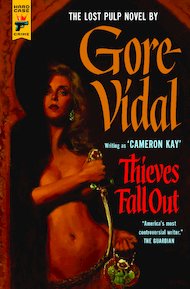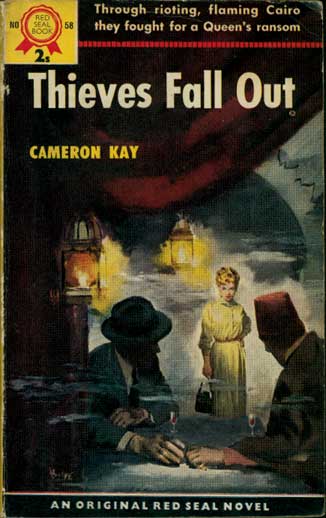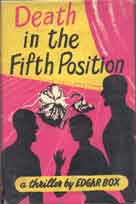

So enduring was the legacy of Edgar Box that 30 years later, in 1985, The Mystery Trivia Quiz Book (above left) featured the question "Who Is Edgar Box" as a teaser on the book's hardcover dust jacket. (Click the small image for a better look.) By this time, Vidal had revealed Box's true identity in 1978's Three by Box, an omnibus hardcover edition from Random House that brought all three books together in one volume. In 2011, the three novels were re-issued in separate editions, each with "Gore Vidal" and "Edgar Box" as the author.
All three of the Box books are breezy, delightful mysteries that were considered "adult reading" in their time. They sold well enough, and they even got some good reviews from unwitting critics who refused to review his literary novels written under his own name.
Vidal had long claimed that for decades, nobody knew he was Edgar Box, but contempoary evidence belies his veil. In 1953, Cumulative Book Index's 1949-1952 volume listed "Edgar Box" as a pseudonym for Gore Vidal. The March 1957 issue of The Magazine of Fantasy and Science Fiction further unmased Vidal as Box, and in Japan, a 1960 paperback of Death Likes It Hot revealed Vidal to be the author of the book (his name appears written in Japanese on the back cover). Finally, in 1978's Three by Box, Vidal himself fessed up. And for a 1964 paperback series of the books - before he came out as Edgar Box - Vidal supplied a blurb for the books' front covers: "The work that Dr. Kinsey began with statistics, Edgar Box has completed with wit in the mystery novel."
So using the name Katherine Everard - the "Everard" was a gay bathhouse in New York where he once took a shocked and titillated Truman Capote - Vidal wrote A Star's Progress (1950), published in hardcover in the U.S. by Dutton (above right), in the U.K. by Quality Press (below left) and in paperback by Pyramid under the title Cry Shame! It's the story of a wise-beyond-her-years 13-year-old who begins her show biz career as a singer in a New Orleans nightclub and eventually becomes a Hollywood star, married to a much older man and in love with an "ambisextrous" movie star. (Think of the actor character from The City and the Pillar.) Her story ends tragically, as all melodramas must.
 The Pyramid paperback edition of the novel contains a three-page
"Prologue" that doesn't appear in the Dutton first edition. This prologue
- which is actually the last three pages of the novel, and which still
appear at the end - foreshadows the outcome of the heroine's life and
gives the reader a strong sense of impending doom, as if to proclaim at
the start, "The fallen woman of this sordid tale will be punished
for her scandalous life." Back in the 1950s, paperbacks were marketed for
less sophisticated readers than hardcover books. So right from the start,
the Pyramid paperback Cry Shame! presents itself as a cautionary
tale that lets readers know that it's protagonist will be punished for
her indecency. Even the paperback
edition's new title undercuts its heroine's stardom and success, replacing
it with an exclamatory scolding. Similarly, the 1950 paperback edition of
The City and Pillar slightly altered the "shocking" ending (by
1948 standards) of the hardcover edition, presumably to avoid offending
its wider audience.
The Pyramid paperback edition of the novel contains a three-page
"Prologue" that doesn't appear in the Dutton first edition. This prologue
- which is actually the last three pages of the novel, and which still
appear at the end - foreshadows the outcome of the heroine's life and
gives the reader a strong sense of impending doom, as if to proclaim at
the start, "The fallen woman of this sordid tale will be punished
for her scandalous life." Back in the 1950s, paperbacks were marketed for
less sophisticated readers than hardcover books. So right from the start,
the Pyramid paperback Cry Shame! presents itself as a cautionary
tale that lets readers know that it's protagonist will be punished for
her indecency. Even the paperback
edition's new title undercuts its heroine's stardom and success, replacing
it with an exclamatory scolding. Similarly, the 1950 paperback edition of
The City and Pillar slightly altered the "shocking" ending (by
1948 standards) of the hardcover edition, presumably to avoid offending
its wider audience.
There is one more difference between the hardcover and paperback editions of the Everard novel. The hardcover has a dedication - "For Gertrude Jackson" - that does not appear in the paperback. According to Vidal's 1995 memoir, Palimpsest, Gertrude Jackson was the "large, dark" cook in the Rock Creek Park home of Vidal's grandfather, Sen. Thomas P. Gore of Oklahoma. Vidal was fond of her. "I used to watch her cook by the hour," he wrote in Palimpsest, "telling her stories that I made up. She was stout, from Maryland's Eastern Shore; she was also sly. She stole a gold pin from Nina [Vidal's mother] and then, a year or two later, absentmindedly wore it to work. We thought that the loss of her cooking was rather more serious than that of a gold pin."

 Katherine Everard did not write a second book, although she was invited to
speak at a women's literary society. (Her publisher politely declined on
her behalf.) A few years later, still in need of money, Vidal adopted the
name Cameron Kay - the name of his great uncle, who was once
attorney general of Texas - and wrote a Fawcett Gold Medal paperback
original called Thieves Fall Out (1953), a tale of
intrigue, adventure and duplicity set in Cairo, where he had spent some
time a few years earlier. (It was also published as a U.K. Red Seal
paperback original edition by L. Miller & Sons.) Vidal wrote A Star's
Progress in a voice of almost eerie omniscience that doesn't sound
quite like anything else in Vidal's canon. Thieves Fall Out
employs the brisk, tongue-in-cheek tone of the Edgar Box novels. "Through
rioting, flaming Cairo," proclaims the book's front cover, "they fought
for a Queen's ransom." The cast of characters includes Hastings, "British
subject, born to be hanged," and Helene, Contesse de Rastignac,
"Parisienne, phony as a three-dollar bill, a lovely vulture." Laced with
wry humor, the novel carries its suspense to an explosive climax: "Small
wonder," says the back cover, "with a cutthroat crew like this on its
register, the world-famed Shepheard's Hotel blew up."
Katherine Everard did not write a second book, although she was invited to
speak at a women's literary society. (Her publisher politely declined on
her behalf.) A few years later, still in need of money, Vidal adopted the
name Cameron Kay - the name of his great uncle, who was once
attorney general of Texas - and wrote a Fawcett Gold Medal paperback
original called Thieves Fall Out (1953), a tale of
intrigue, adventure and duplicity set in Cairo, where he had spent some
time a few years earlier. (It was also published as a U.K. Red Seal
paperback original edition by L. Miller & Sons.) Vidal wrote A Star's
Progress in a voice of almost eerie omniscience that doesn't sound
quite like anything else in Vidal's canon. Thieves Fall Out
employs the brisk, tongue-in-cheek tone of the Edgar Box novels. "Through
rioting, flaming Cairo," proclaims the book's front cover, "they fought
for a Queen's ransom." The cast of characters includes Hastings, "British
subject, born to be hanged," and Helene, Contesse de Rastignac,
"Parisienne, phony as a three-dollar bill, a lovely vulture." Laced with
wry humor, the novel carries its suspense to an explosive climax: "Small
wonder," says the back cover, "with a cutthroat crew like this on its
register, the world-famed Shepheard's Hotel blew up."
Vidal never liked this book - he only wrote it for money - so in 2004, when a publisher approached him about reprinting it, he said no. But after Vidal's death, his literary executors agreed to a reprint, which appeared in April 2015. The publisher, Charles Ardai, decided to honor the book's roots and issue it not as a literary novel but as a pulp fiction, with a cover featuring a scantily clad woman who looks like she's out for trouble (or has already gotten into some). Jay Parini, a long-time friend of Vidal and author of a 2015 biography about him, excoriated the decision to reissue the novel, which Ardai says he discovered through The Gore Vidal Index.
 FEATURED PAGE
FEATURED PAGE 
 In the early 1950s, Vidal wrote one more pulp novel, Some
Desperate Adventure, which he never published and may never even
have finished: The last chapter is missing from the manuscript pages in
the Vidal Archives, which are now lodged at Harvard. The story concerns a
young New York fellow who hustles men for money despite having a
girlfriend and claiming to be heterosexual. He's called one day to the
mansion of a mysterious rich man, where he discovers the arrangements of
the man's life and death. It's a creepy tale, rather like an adult
episode of The Twilight Zone. Almost 50 years later, Vidal said
he did the novel merely as an experiment in using a Dictophone and now
can't recall whether he finished it.
In the early 1950s, Vidal wrote one more pulp novel, Some
Desperate Adventure, which he never published and may never even
have finished: The last chapter is missing from the manuscript pages in
the Vidal Archives, which are now lodged at Harvard. The story concerns a
young New York fellow who hustles men for money despite having a
girlfriend and claiming to be heterosexual. He's called one day to the
mansion of a mysterious rich man, where he discovers the arrangements of
the man's life and death. It's a creepy tale, rather like an adult
episode of The Twilight Zone. Almost 50 years later, Vidal said
he did the novel merely as an experiment in using a Dictophone and now
can't recall whether he finished it.
At the top of the title page of the manuscript of Some Desperate Adventure, in Vidal's handwriting, is this brief note: "Nick, let's think up a new title." This certainly refers to Nicholas Wreden, Vidal's editor at Dutton in the 1940s and 1950s. So it seems Vidal intended to have Dutton publish this pulp fiction in a hardcover edition, just as Dutton had published A Star's Progress, although whether Vidal would have chosen a new pseudonym remains another of the book's mysteries.
And finally, Vidal adopted one other pseudonym: Using the cryptic name "Libra," he wrote an essay called "Ladders to Heaven: Novelists and Critics," which he published in October 1953 in the fourth edition of New World Writing, a paperback anthology series that featured literature and criticism. Vidal helped found New World Writing a few years earlier, and the fourth edition also includes his short story "The Ladies in the Library." So to avoid being too ubiquitous in the book, he adopted a one-time-only secret identity. The essay, which appears at the end of the book, has the name "Libra" at the top of the piece and, just beneath it, informs the reader: "This is the pseudonym of one of the better-known young American novelists."
 In the essay, an overly modest Vidal only mentions himself twice.
First, in passing, he observes: "McCullers, Bowles, Vidal and Capote are
not graduates of universities, and many of the other young lions have had
enough war to wash them clean of academicism." A page later, he tartly
chides the scholar John Aldridge - who had earlier criticized Vidal's work
as being increasingly unimportant and unfulfilled - for discussing "a
number of fictitious characters who were writing books (using real, if
unlikely, names like Truman Capote and Gore Vidal) and he proved, by
evidence of their works, that they had all failed of greatness." Thus in
the guise of Libra, Vidal exacts a touch of literary revenge.
In the essay, an overly modest Vidal only mentions himself twice.
First, in passing, he observes: "McCullers, Bowles, Vidal and Capote are
not graduates of universities, and many of the other young lions have had
enough war to wash them clean of academicism." A page later, he tartly
chides the scholar John Aldridge - who had earlier criticized Vidal's work
as being increasingly unimportant and unfulfilled - for discussing "a
number of fictitious characters who were writing books (using real, if
unlikely, names like Truman Capote and Gore Vidal) and he proved, by
evidence of their works, that they had all failed of greatness." Thus in
the guise of Libra, Vidal exacts a touch of literary revenge.
He would reprint the essay under his own name in subsequent years in various essay collections, renaming it "Ladders to Heaven: Novelists and Critics of the 1940s." And what of the coy references to himself? For the first, where he lists noted writers who did not attend university, he replaces his own name with an "etc." For the second, he retains his playful illeism.
Incidentally, regarding his choice of this pseudonym, Vidal was born on Oct. 3, so Libra is his Zodiac birth sign. Perhaps that's a good stroke of luck because Libra represents "the arm of a balance," which further suggests that his piece had a fair and balanced view of its subject matter (as he believes all of his writing does).
 Return to the Gore Vidal
Thumbnails introduction
Return to the Gore Vidal
Thumbnails introduction
If you came right to this thumbnail page and don't see a frame on the left, please visit The Gore Vidal Index now or after you've enjoyed the thumbnails, which you can access from the main index page. And please send me comments if you have a thought, a suggestion or a link to add to the index.
ęCopyright 2005 by
Harry Kloman
University of Pittsburgh
kloman@pitt.edu